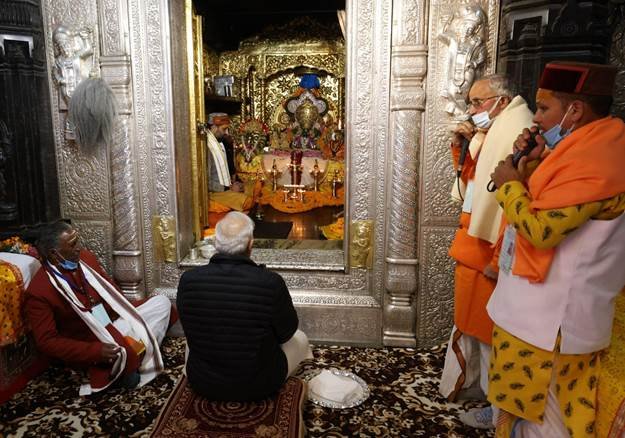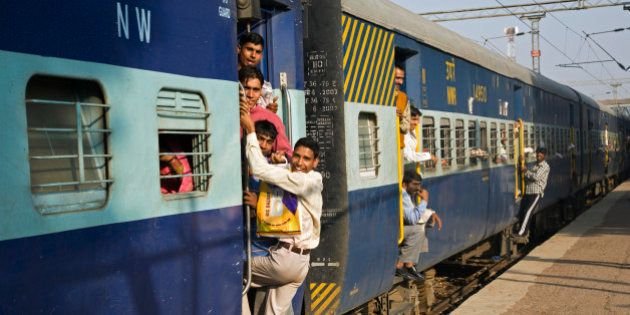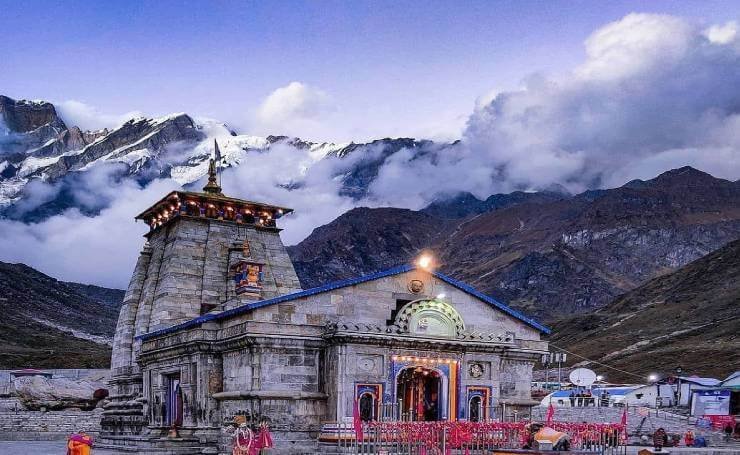The spiritual sanctuary of Badrinath is located in Uttarakhand, nestled among the calm glory of the Himalayas. This ancient pilgrimage destination, revered for its spiritual significance and breathtaking natural beauty, has served as a symbol of devotion and peace for ages. When travelers and devotees visit Badrinath, they are greeted by the towering peaks and beautiful valleys of the Himalayan scenery, which inspires amazement and reverence. However, amid the mesmerizing charm of this divine sanctuary, a question emerges in the hearts of pilgrims and wanderers alike: How many days are sufficient to visit Badrinath’s spiritual aura and endless beauties?
The Badrinath temple, dedicated to Lord Vishnu, is one of the sacred Char Dhams in Uttarakhand, in far northern India. These four ancient Hindu temples are considered the spiritual rivers of four sacred rivers: the Alaknanda River at Badrinath Temple, the Ganges River at Gangotri Temple, the Yamuna River at Yamunotri Temple, and the Mandakini River at Kedarnath Temple. Hindus believe that visiting these temples will wash away their sins and allow them to achieve moksha (liberation from the cycle of death and rebirth).
Badrinath is also one of four sacred Char Dhams, or abodes of Lord Vishnu avatars, located throughout India in all four directions. The remaining three are Dwarka in Gujarat, Rameshwaram in Tamil Nadu, and Puri in Odisha.
How Many Days Are Sufficient to Visit Badrinath?
The number of days required to visit Badrinath is determined by the activities and places you want to see. A minimum of 2–3 days is usually required to visit the key attractions in and around Badrinath.
This is a suggested itinerary:
Day 1: Haridwar to Badrinath
Start early from Haridwar and arrive in Badrinath by nightfall.
Visit the Badrinath Temple and bathe in the hot springs.
Check out the nearby market and taste some local cuisine.
Day 2: Badrinath sightseeing
Visit Mana village, the last town on the India-China frontier.
Explore the neighboring sites, including Bheem Pul, Vyas Cave, and Ganesh Gufa.
Trek to the Vasudhara Falls, a beautiful waterfall located approximately 6 kilometers from Badrinath.
Day 3: Badrinath to Haridwar
Begin your journey back to Haridwar after breakfast.
En route, stop in Joshimath and explore adjacent sights such as the Narsingh Temple and the Kalpavriksha.
Reach Haridwar in the evening.
If you have additional time, consider visiting neighboring sights such as Auli Ski Resort, Valley of Flowers National Park, and Hemkund Sahib.
It is best to examine the weather and road conditions before organizing your trip and to leave an extra day in case of unexpected occurrences.
Devdham Yatra also offers a variety of cheap Badrinath Yatra tour packages. They provide hassle-free trips and the greatest services. So, you can arrange your vacation to Badrinath with the Dev Dham Yatra.
What to See at the Badrinath Temple
The temple’s 3.3-foot-tall black stone statue of Lord Badrinarayan is seated in a meditation stance, rather than his typical reclining pose, beneath a badri tree and pure gold roof.
There are idols of 15 more gods on the temple grounds, some in the inner sanctuary and others outside. These include Uddhava (Lord Krishna’s buddy and devotee), Garuda (Lord Vishnu’s vehicle), Kuber (the wealth deity), Lord Ganesh, Nara and Narayana, Shri Devi and Bhudevi, and Goddess Lakshmi.
Tapt Kund, a medicinal hot salt spring beneath the temple, is also open for pilgrims to bathe in before entering.
Darshan Timings
The daily rituals at the Badrinath temple begin at 4:30 a.m. with the Maha Abhishek and Abhishek Puja. Depending on how much time and money you have available, there are several choices for viewing Lord Badri Narayan’s idol inside the temple. The general public can attend these rites by making a reservation and paying a charge of around 4,100 rupees each individual. It’s a peaceful and fascinating way to view the idol.
The temple is open to the public every morning at 6:30 a.m. and closes at noon. It’s open again from 3 to 9 p.m. The most auspicious time to visit is at 6:30 a.m. for the first public puja (prayer) of the day, which might get busy.
The temple ceremonies continue throughout the day, with prices ranging from 151 rupees for the evening Kapoor Aarti to 35,101 rupees for the seven-day Shrimad Bhagwat Saptah Path Puja. Attending the temple’s daily ceremonies costs 11,700 rupees each person.
During peak periods, individuals who do not wish to pay extra to avoid the line should expect to wait a couple of hours to see the idol, even if they arrive early. Be prepared to just catch a glimpse of the idol for a few seconds as temple priests rush visitors through.
The temple has a token system in place to manage pilgrim admission according to set times. However, it does not always work.
When viewing the god, it is traditional to make a devotional offering (known as prasad) in order to get blessing. This is available in the temple and often comprises candies, dried fruits, and tulsi (holy basil).
Take notice that photography is not permitted inside the shrine.

Also Read: Essential Gears for Solo Travellers
How To Visit Badrinath
Badrinath Temple is frequently visited as part of a pilgrimage to Uttarakhand’s Char Dham. It is the most accessible of the four temples and one of the most popular in India. However, the shrine was not always so easily accessible. Before 1962, there was no road access, so people had to trek across the mountains to get there.
The most frequent way to visit the temple is as a day excursion from Joshimath, while there are some lodgings available in Badrinath. Those who are on the Char Dham Yatra pilgrimage would normally arrive at Badrinath temple after seeing Kedarnath shrine and traveling from either Gauri Kund or Sonprayag.
Badrinath Temple is located roughly 10,200 feet (3,100 meters) above sea level in front of the majestic Neelkanth Peak, between the twin Nara and Narayana mountain ranges. It is located in Badrinath, approximately 28 miles (45 kilometers) north of Joshimath. Despite the short distance, the trip from Joshimath to Badrinath typically takes two to three hours due to the mountainous landscape and difficult road conditions.
- By Helicopter: The easiest but most expensive way to get to the temple is by helicopter. Pilgrimage Aviation, a private firm, offers one-day trips to Badrinath that depart from Dehradun’s Sahastradhara helipad.
- By Car: Unfortunately, the nearest train station to Badrinath is Haridwar, which is around 10 hours away from Joshimath by road. It is most convenient to hire a car and driver from Haridwar, and these vehicles are available at the station. Most automobile rental businesses charge per day, which includes a return trip. Expect to pay 3,000 rupees per day or more, depending on the type of car. You’ll need to leave as early as possible (by 7 a.m.) to get to Joshimath before the sun sets. Driving on mountain roads at night is prohibited in Uttarakhand due to safety concerns.
- Shared Jeep or Bus: If cost is an issue, shared jeeps and buses are a cheaper option. These leave early in the morning from Natraj Chowk in Rishikesh, approximately 25 kilometers from Haridwar.
Here’s how to travel from Haridwar to Rishikesh:
Jeep drivers will wait until the jeeps are full, usually 12 to 14 people, before leaving. Taking the bus will add a few hours to your travel time because it is operated by the local government. Although the buses are not air-conditioned and the seats do not recline, they are more comfortable than crowded jeeps! The buses begin running around 5 a.m. from near Haridwar railway station and continue all the way to Badrinath. However, if the weather turns bad in the late afternoon, you may end up trapped between Joshimath and Badrinath. The route is prone to landslides during the rainy season, making travel difficult.
Another option is to take a bus from Rishikesh to Srinagar (not Kashmir!) or Rudraprayag, then a shared taxi to Badrinath. They run regularly, and the drivers aren’t very concerned with filling the jeeps to capacity.
When driving from Joshimath to Badrinath, it is best to depart Joshimath early in the morning (before 8 a.m.) Because of the road’s narrowness, traffic is frequently restricted during peak season in May and June, with vehicles only permitted to travel in specific directions at certain times. The view, however, is amazing!

Best Time to Visit the Badrinath Temple
Due to adverse weather conditions, the Badrinath temple is only open for six months per year, from the end of April or early May until the beginning of November. The priests decide when the temple will open on the auspicious occasion of Basant Panchami, which occurs in January or February and celebrates the arrival of spring. The closing date is set for Dussehra. Generally, the temple remains open for around ten days after Diwali.
To avoid crowds and harsh weather, October (or November, if the temple is still open) is considered the best time to visit. It is not as busy as the peak season of May to June, and the wet monsoon season of June to September has ended.
Keep in mind that the weather in Badrinath can be unpredictable, with cold nights and wet or sunny days. So pack appropriately.
If you want to attend a festival at the temple, Krishna Janmashtami is celebrated in August or early September; the Mata Murti ka Mela is held in September on the anniversary of Vaman Dwadashi; and there are festivities when the temple opens and closes each year. However, it will be really busy! Many people attend the opening to observe the glowing candle that the priest lit before closing the temple the previous year.


